EduStream Project: Risk Management Plan - ICT508 Assignment 2
VerifiedAdded on 2022/11/14
|14
|4808
|190
Project
AI Summary
This document presents the EduStream Risk Management Plan (RMP), developed to ensure the success of the EduStream project by providing a consistent method for managing risks. The RMP outlines the objectives, guiding principles, and project scope, which includes developing a video streaming and games server solution. The plan details the risk management organization, including the roles and responsibilities of the Project Risk Manager (PRM), Project Manager, and Risk Owners (ROs). The core of the RMP is the risk management process, encompassing risk identification, analysis (qualitative and quantitative), risk response planning, and risk control. The plan emphasizes the importance of identifying risks and logging them in a Risk Register, which includes details such as risk descriptions, potential impacts, risk levels, and mitigation strategies. The analysis phase involves both qualitative and quantitative methods to assess risks. Risk response planning focuses on developing strategies for very high, high, and moderate-level risks. The document includes tables and matrices for risk assessment and action planning. The RMP provides a structured approach to managing potential issues throughout the project lifecycle, ensuring proactive risk mitigation and stakeholder communication.
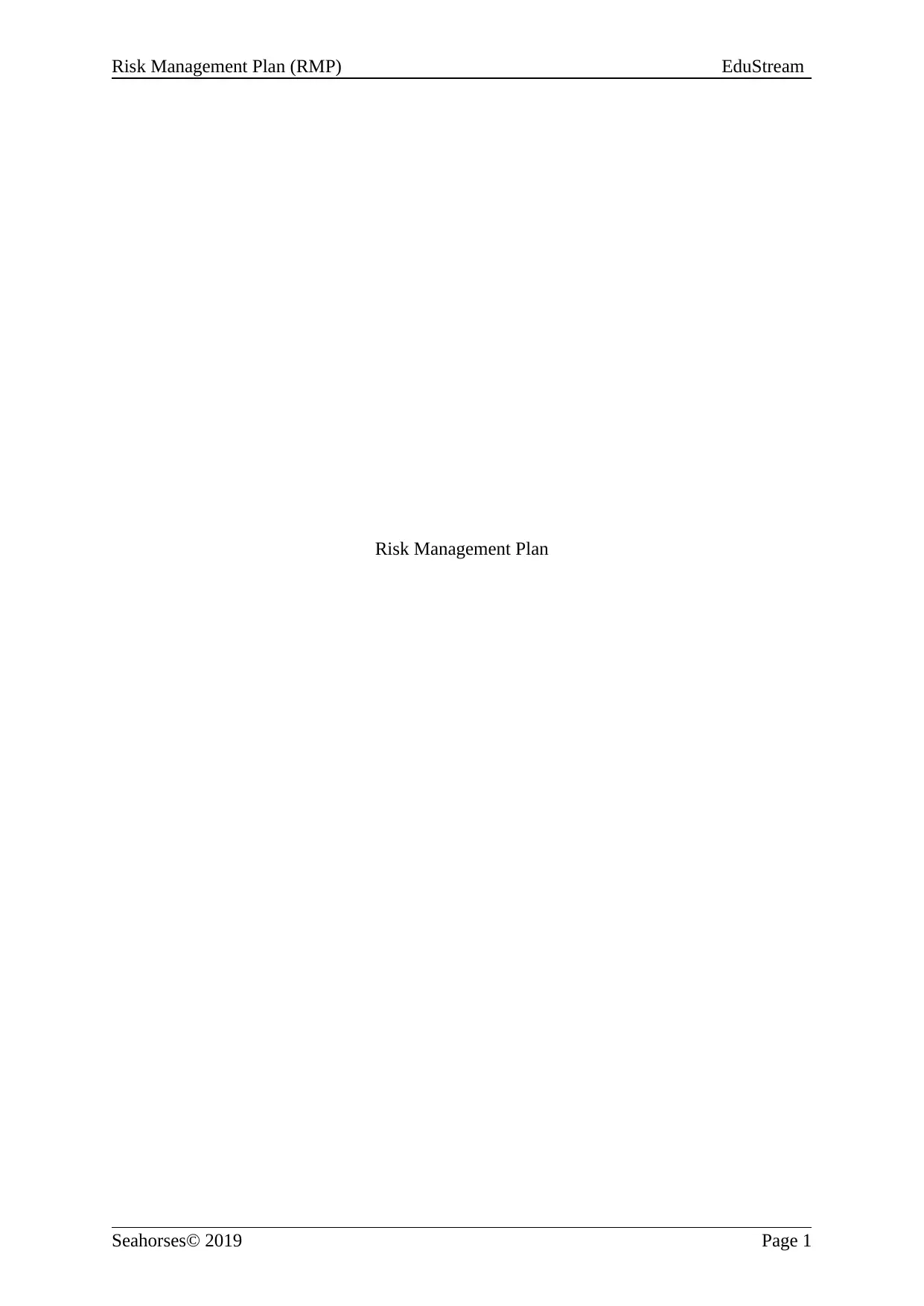
Risk Management Plan (RMP) EduStream
Risk Management Plan
Seahorses© 2019 Page 1
Risk Management Plan
Seahorses© 2019 Page 1
Paraphrase This Document
Need a fresh take? Get an instant paraphrase of this document with our AI Paraphraser
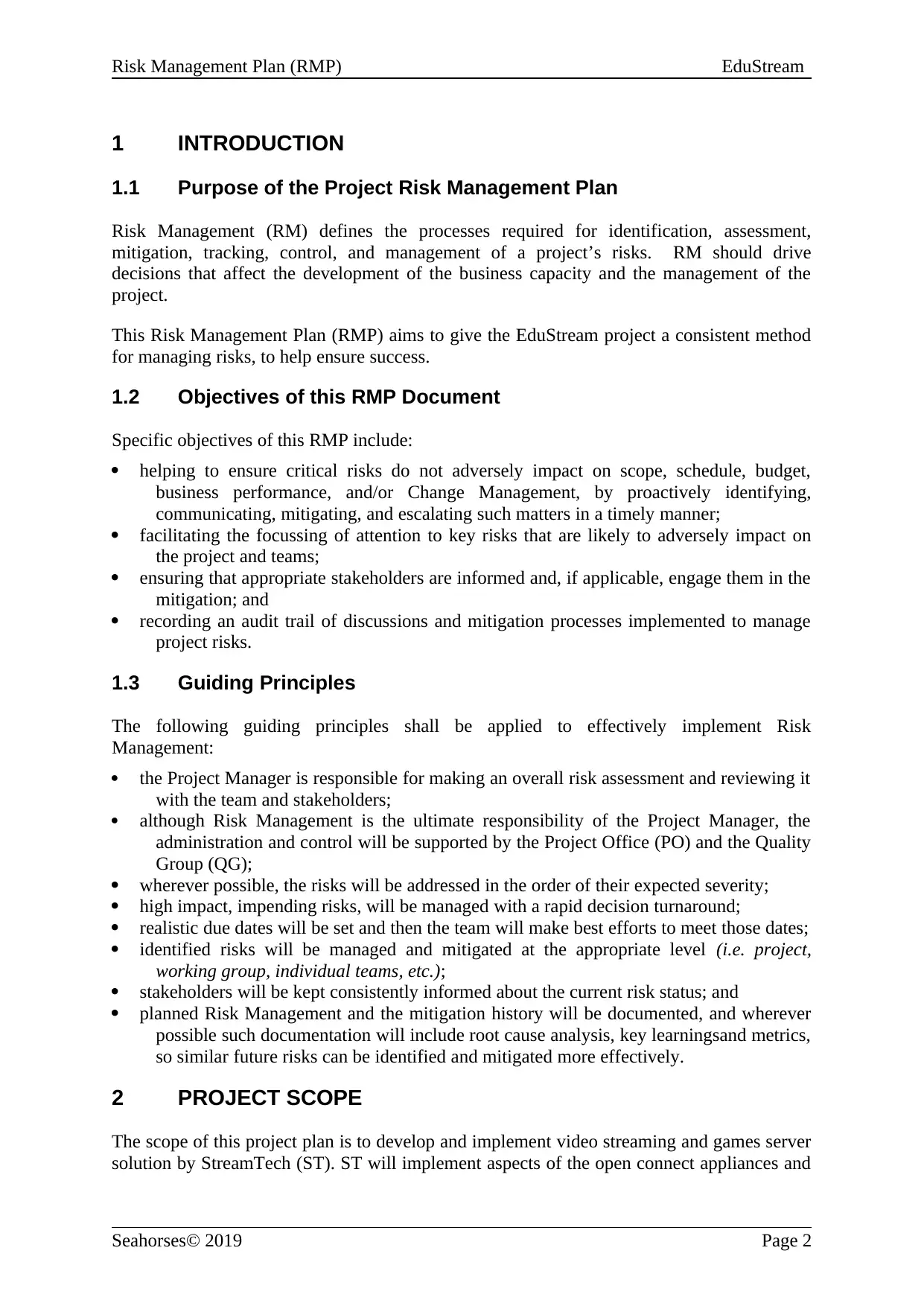
Risk Management Plan (RMP) EduStream
1 INTRODUCTION
1.1 Purpose of the Project Risk Management Plan
Risk Management (RM) defines the processes required for identification, assessment,
mitigation, tracking, control, and management of a project’s risks. RM should drive
decisions that affect the development of the business capacity and the management of the
project.
This Risk Management Plan (RMP) aims to give the EduStream project a consistent method
for managing risks, to help ensure success.
1.2 Objectives of this RMP Document
Specific objectives of this RMP include:
helping to ensure critical risks do not adversely impact on scope, schedule, budget,
business performance, and/or Change Management, by proactively identifying,
communicating, mitigating, and escalating such matters in a timely manner;
facilitating the focussing of attention to key risks that are likely to adversely impact on
the project and teams;
ensuring that appropriate stakeholders are informed and, if applicable, engage them in the
mitigation; and
recording an audit trail of discussions and mitigation processes implemented to manage
project risks.
1.3 Guiding Principles
The following guiding principles shall be applied to effectively implement Risk
Management:
the Project Manager is responsible for making an overall risk assessment and reviewing it
with the team and stakeholders;
although Risk Management is the ultimate responsibility of the Project Manager, the
administration and control will be supported by the Project Office (PO) and the Quality
Group (QG);
wherever possible, the risks will be addressed in the order of their expected severity;
high impact, impending risks, will be managed with a rapid decision turnaround;
realistic due dates will be set and then the team will make best efforts to meet those dates;
identified risks will be managed and mitigated at the appropriate level (i.e. project,
working group, individual teams, etc.);
stakeholders will be kept consistently informed about the current risk status; and
planned Risk Management and the mitigation history will be documented, and wherever
possible such documentation will include root cause analysis, key learningsand metrics,
so similar future risks can be identified and mitigated more effectively.
2 PROJECT SCOPE
The scope of this project plan is to develop and implement video streaming and games server
solution by StreamTech (ST). ST will implement aspects of the open connect appliances and
Seahorses© 2019 Page 2
1 INTRODUCTION
1.1 Purpose of the Project Risk Management Plan
Risk Management (RM) defines the processes required for identification, assessment,
mitigation, tracking, control, and management of a project’s risks. RM should drive
decisions that affect the development of the business capacity and the management of the
project.
This Risk Management Plan (RMP) aims to give the EduStream project a consistent method
for managing risks, to help ensure success.
1.2 Objectives of this RMP Document
Specific objectives of this RMP include:
helping to ensure critical risks do not adversely impact on scope, schedule, budget,
business performance, and/or Change Management, by proactively identifying,
communicating, mitigating, and escalating such matters in a timely manner;
facilitating the focussing of attention to key risks that are likely to adversely impact on
the project and teams;
ensuring that appropriate stakeholders are informed and, if applicable, engage them in the
mitigation; and
recording an audit trail of discussions and mitigation processes implemented to manage
project risks.
1.3 Guiding Principles
The following guiding principles shall be applied to effectively implement Risk
Management:
the Project Manager is responsible for making an overall risk assessment and reviewing it
with the team and stakeholders;
although Risk Management is the ultimate responsibility of the Project Manager, the
administration and control will be supported by the Project Office (PO) and the Quality
Group (QG);
wherever possible, the risks will be addressed in the order of their expected severity;
high impact, impending risks, will be managed with a rapid decision turnaround;
realistic due dates will be set and then the team will make best efforts to meet those dates;
identified risks will be managed and mitigated at the appropriate level (i.e. project,
working group, individual teams, etc.);
stakeholders will be kept consistently informed about the current risk status; and
planned Risk Management and the mitigation history will be documented, and wherever
possible such documentation will include root cause analysis, key learningsand metrics,
so similar future risks can be identified and mitigated more effectively.
2 PROJECT SCOPE
The scope of this project plan is to develop and implement video streaming and games server
solution by StreamTech (ST). ST will implement aspects of the open connect appliances and
Seahorses© 2019 Page 2
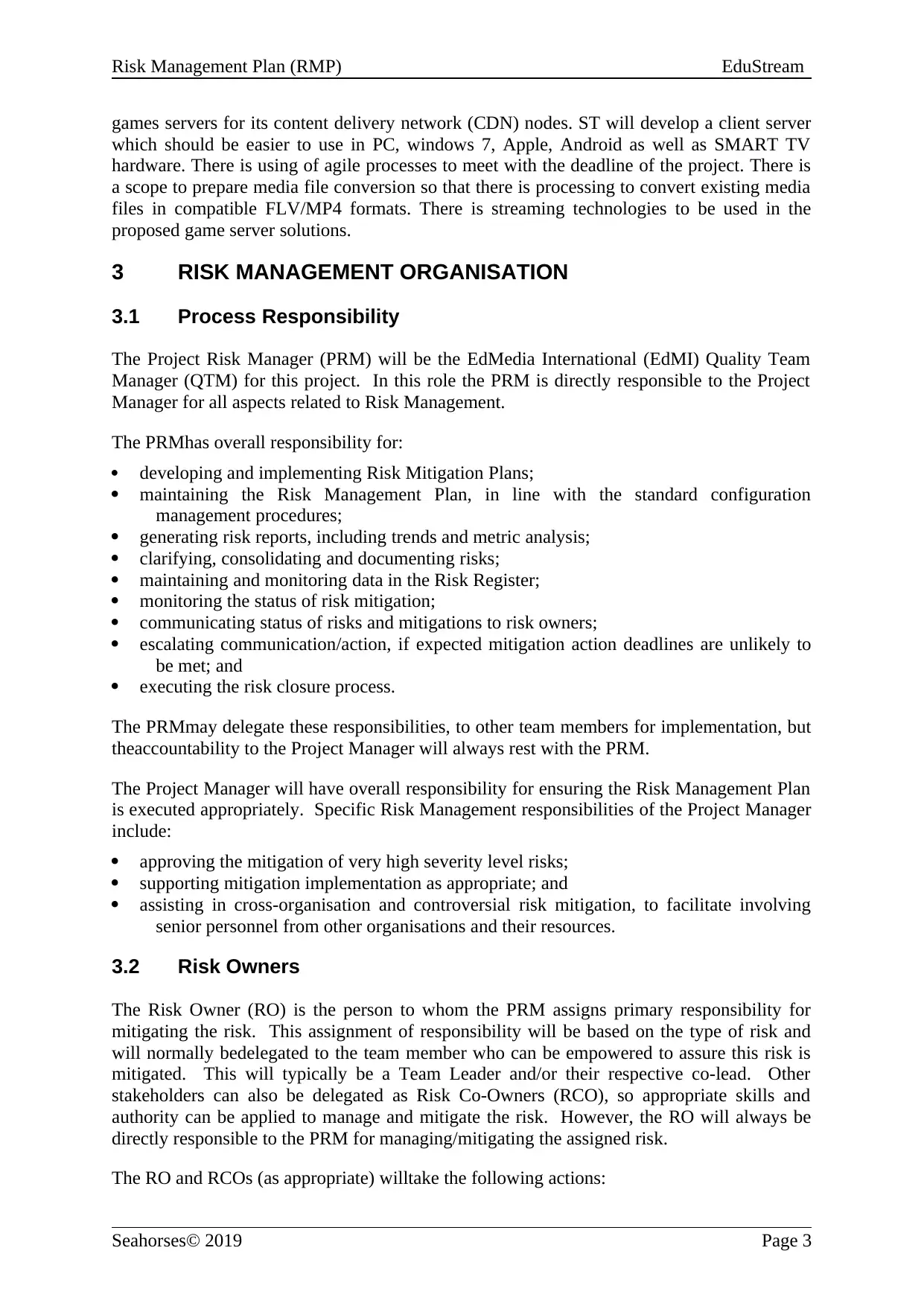
Risk Management Plan (RMP) EduStream
games servers for its content delivery network (CDN) nodes. ST will develop a client server
which should be easier to use in PC, windows 7, Apple, Android as well as SMART TV
hardware. There is using of agile processes to meet with the deadline of the project. There is
a scope to prepare media file conversion so that there is processing to convert existing media
files in compatible FLV/MP4 formats. There is streaming technologies to be used in the
proposed game server solutions.
3 RISK MANAGEMENT ORGANISATION
3.1 Process Responsibility
The Project Risk Manager (PRM) will be the EdMedia International (EdMI) Quality Team
Manager (QTM) for this project. In this role the PRM is directly responsible to the Project
Manager for all aspects related to Risk Management.
The PRMhas overall responsibility for:
developing and implementing Risk Mitigation Plans;
maintaining the Risk Management Plan, in line with the standard configuration
management procedures;
generating risk reports, including trends and metric analysis;
clarifying, consolidating and documenting risks;
maintaining and monitoring data in the Risk Register;
monitoring the status of risk mitigation;
communicating status of risks and mitigations to risk owners;
escalating communication/action, if expected mitigation action deadlines are unlikely to
be met; and
executing the risk closure process.
The PRMmay delegate these responsibilities, to other team members for implementation, but
theaccountability to the Project Manager will always rest with the PRM.
The Project Manager will have overall responsibility for ensuring the Risk Management Plan
is executed appropriately. Specific Risk Management responsibilities of the Project Manager
include:
approving the mitigation of very high severity level risks;
supporting mitigation implementation as appropriate; and
assisting in cross-organisation and controversial risk mitigation, to facilitate involving
senior personnel from other organisations and their resources.
3.2 Risk Owners
The Risk Owner (RO) is the person to whom the PRM assigns primary responsibility for
mitigating the risk. This assignment of responsibility will be based on the type of risk and
will normally bedelegated to the team member who can be empowered to assure this risk is
mitigated. This will typically be a Team Leader and/or their respective co-lead. Other
stakeholders can also be delegated as Risk Co-Owners (RCO), so appropriate skills and
authority can be applied to manage and mitigate the risk. However, the RO will always be
directly responsible to the PRM for managing/mitigating the assigned risk.
The RO and RCOs (as appropriate) willtake the following actions:
Seahorses© 2019 Page 3
games servers for its content delivery network (CDN) nodes. ST will develop a client server
which should be easier to use in PC, windows 7, Apple, Android as well as SMART TV
hardware. There is using of agile processes to meet with the deadline of the project. There is
a scope to prepare media file conversion so that there is processing to convert existing media
files in compatible FLV/MP4 formats. There is streaming technologies to be used in the
proposed game server solutions.
3 RISK MANAGEMENT ORGANISATION
3.1 Process Responsibility
The Project Risk Manager (PRM) will be the EdMedia International (EdMI) Quality Team
Manager (QTM) for this project. In this role the PRM is directly responsible to the Project
Manager for all aspects related to Risk Management.
The PRMhas overall responsibility for:
developing and implementing Risk Mitigation Plans;
maintaining the Risk Management Plan, in line with the standard configuration
management procedures;
generating risk reports, including trends and metric analysis;
clarifying, consolidating and documenting risks;
maintaining and monitoring data in the Risk Register;
monitoring the status of risk mitigation;
communicating status of risks and mitigations to risk owners;
escalating communication/action, if expected mitigation action deadlines are unlikely to
be met; and
executing the risk closure process.
The PRMmay delegate these responsibilities, to other team members for implementation, but
theaccountability to the Project Manager will always rest with the PRM.
The Project Manager will have overall responsibility for ensuring the Risk Management Plan
is executed appropriately. Specific Risk Management responsibilities of the Project Manager
include:
approving the mitigation of very high severity level risks;
supporting mitigation implementation as appropriate; and
assisting in cross-organisation and controversial risk mitigation, to facilitate involving
senior personnel from other organisations and their resources.
3.2 Risk Owners
The Risk Owner (RO) is the person to whom the PRM assigns primary responsibility for
mitigating the risk. This assignment of responsibility will be based on the type of risk and
will normally bedelegated to the team member who can be empowered to assure this risk is
mitigated. This will typically be a Team Leader and/or their respective co-lead. Other
stakeholders can also be delegated as Risk Co-Owners (RCO), so appropriate skills and
authority can be applied to manage and mitigate the risk. However, the RO will always be
directly responsible to the PRM for managing/mitigating the assigned risk.
The RO and RCOs (as appropriate) willtake the following actions:
Seahorses© 2019 Page 3
⊘ This is a preview!⊘
Do you want full access?
Subscribe today to unlock all pages.

Trusted by 1+ million students worldwide
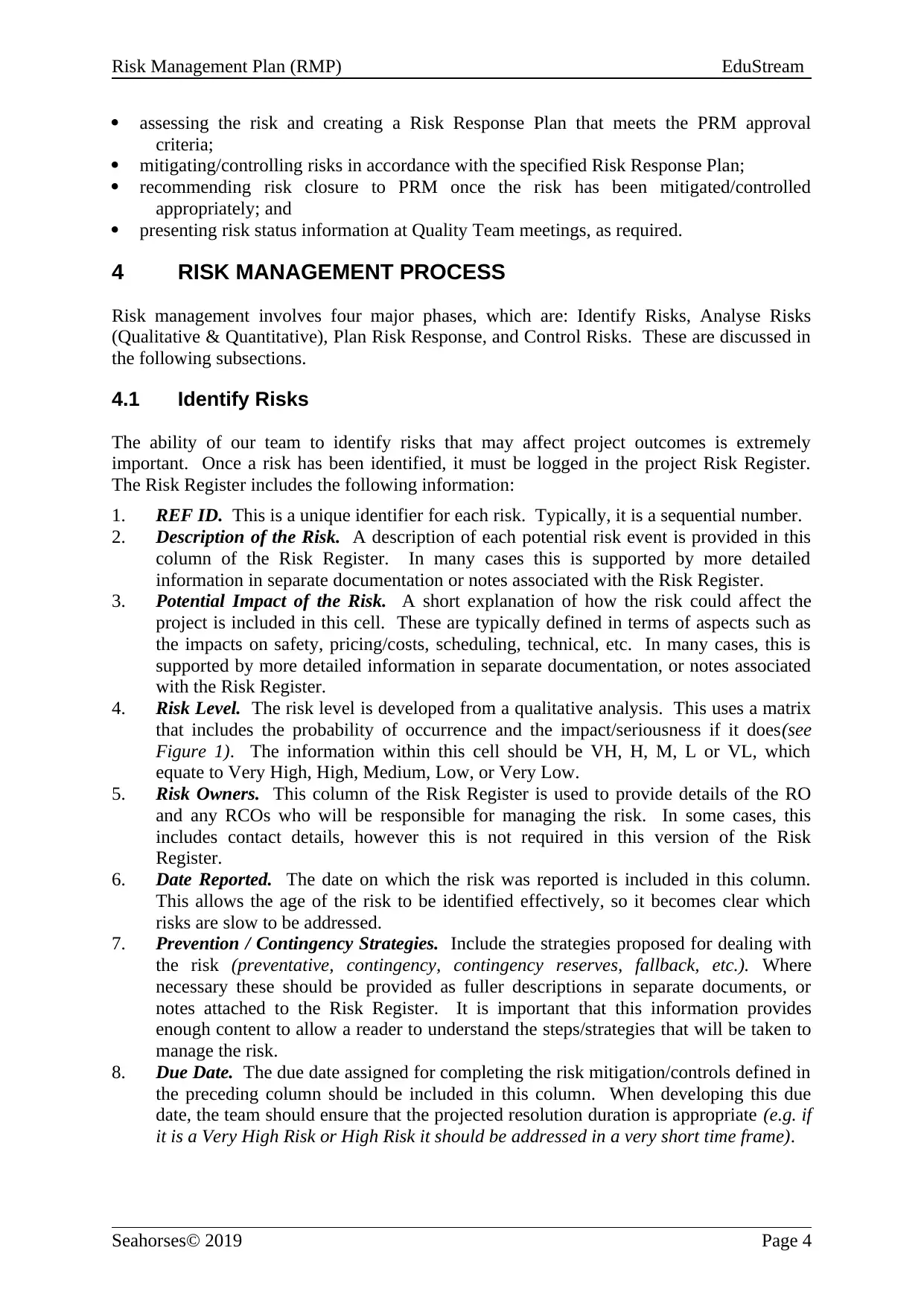
Risk Management Plan (RMP) EduStream
assessing the risk and creating a Risk Response Plan that meets the PRM approval
criteria;
mitigating/controlling risks in accordance with the specified Risk Response Plan;
recommending risk closure to PRM once the risk has been mitigated/controlled
appropriately; and
presenting risk status information at Quality Team meetings, as required.
4 RISK MANAGEMENT PROCESS
Risk management involves four major phases, which are: Identify Risks, Analyse Risks
(Qualitative & Quantitative), Plan Risk Response, and Control Risks. These are discussed in
the following subsections.
4.1 Identify Risks
The ability of our team to identify risks that may affect project outcomes is extremely
important. Once a risk has been identified, it must be logged in the project Risk Register.
The Risk Register includes the following information:
1. REF ID. This is a unique identifier for each risk. Typically, it is a sequential number.
2. Description of the Risk. A description of each potential risk event is provided in this
column of the Risk Register. In many cases this is supported by more detailed
information in separate documentation or notes associated with the Risk Register.
3. Potential Impact of the Risk. A short explanation of how the risk could affect the
project is included in this cell. These are typically defined in terms of aspects such as
the impacts on safety, pricing/costs, scheduling, technical, etc. In many cases, this is
supported by more detailed information in separate documentation, or notes associated
with the Risk Register.
4. Risk Level. The risk level is developed from a qualitative analysis. This uses a matrix
that includes the probability of occurrence and the impact/seriousness if it does(see
Figure 1). The information within this cell should be VH, H, M, L or VL, which
equate to Very High, High, Medium, Low, or Very Low.
5. Risk Owners. This column of the Risk Register is used to provide details of the RO
and any RCOs who will be responsible for managing the risk. In some cases, this
includes contact details, however this is not required in this version of the Risk
Register.
6. Date Reported. The date on which the risk was reported is included in this column.
This allows the age of the risk to be identified effectively, so it becomes clear which
risks are slow to be addressed.
7. Prevention / Contingency Strategies. Include the strategies proposed for dealing with
the risk (preventative, contingency, contingency reserves, fallback, etc.). Where
necessary these should be provided as fuller descriptions in separate documents, or
notes attached to the Risk Register. It is important that this information provides
enough content to allow a reader to understand the steps/strategies that will be taken to
manage the risk.
8. Due Date. The due date assigned for completing the risk mitigation/controls defined in
the preceding column should be included in this column. When developing this due
date, the team should ensure that the projected resolution duration is appropriate (e.g. if
it is a Very High Risk or High Risk it should be addressed in a very short time frame).
Seahorses© 2019 Page 4
assessing the risk and creating a Risk Response Plan that meets the PRM approval
criteria;
mitigating/controlling risks in accordance with the specified Risk Response Plan;
recommending risk closure to PRM once the risk has been mitigated/controlled
appropriately; and
presenting risk status information at Quality Team meetings, as required.
4 RISK MANAGEMENT PROCESS
Risk management involves four major phases, which are: Identify Risks, Analyse Risks
(Qualitative & Quantitative), Plan Risk Response, and Control Risks. These are discussed in
the following subsections.
4.1 Identify Risks
The ability of our team to identify risks that may affect project outcomes is extremely
important. Once a risk has been identified, it must be logged in the project Risk Register.
The Risk Register includes the following information:
1. REF ID. This is a unique identifier for each risk. Typically, it is a sequential number.
2. Description of the Risk. A description of each potential risk event is provided in this
column of the Risk Register. In many cases this is supported by more detailed
information in separate documentation or notes associated with the Risk Register.
3. Potential Impact of the Risk. A short explanation of how the risk could affect the
project is included in this cell. These are typically defined in terms of aspects such as
the impacts on safety, pricing/costs, scheduling, technical, etc. In many cases, this is
supported by more detailed information in separate documentation, or notes associated
with the Risk Register.
4. Risk Level. The risk level is developed from a qualitative analysis. This uses a matrix
that includes the probability of occurrence and the impact/seriousness if it does(see
Figure 1). The information within this cell should be VH, H, M, L or VL, which
equate to Very High, High, Medium, Low, or Very Low.
5. Risk Owners. This column of the Risk Register is used to provide details of the RO
and any RCOs who will be responsible for managing the risk. In some cases, this
includes contact details, however this is not required in this version of the Risk
Register.
6. Date Reported. The date on which the risk was reported is included in this column.
This allows the age of the risk to be identified effectively, so it becomes clear which
risks are slow to be addressed.
7. Prevention / Contingency Strategies. Include the strategies proposed for dealing with
the risk (preventative, contingency, contingency reserves, fallback, etc.). Where
necessary these should be provided as fuller descriptions in separate documents, or
notes attached to the Risk Register. It is important that this information provides
enough content to allow a reader to understand the steps/strategies that will be taken to
manage the risk.
8. Due Date. The due date assigned for completing the risk mitigation/controls defined in
the preceding column should be included in this column. When developing this due
date, the team should ensure that the projected resolution duration is appropriate (e.g. if
it is a Very High Risk or High Risk it should be addressed in a very short time frame).
Seahorses© 2019 Page 4
Paraphrase This Document
Need a fresh take? Get an instant paraphrase of this document with our AI Paraphraser
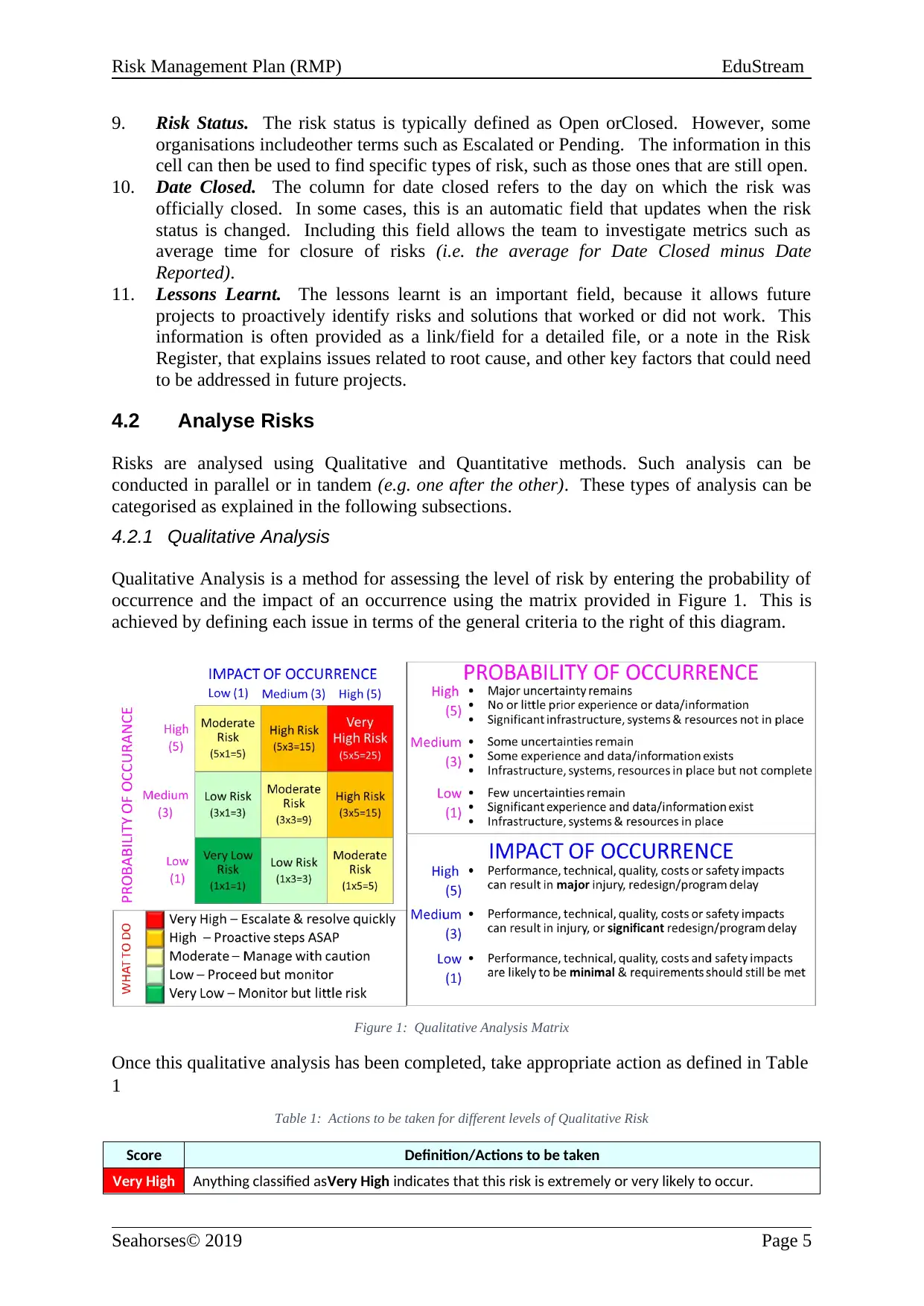
Risk Management Plan (RMP) EduStream
9. Risk Status. The risk status is typically defined as Open orClosed. However, some
organisations includeother terms such as Escalated or Pending. The information in this
cell can then be used to find specific types of risk, such as those ones that are still open.
10. Date Closed. The column for date closed refers to the day on which the risk was
officially closed. In some cases, this is an automatic field that updates when the risk
status is changed. Including this field allows the team to investigate metrics such as
average time for closure of risks (i.e. the average for Date Closed minus Date
Reported).
11. Lessons Learnt. The lessons learnt is an important field, because it allows future
projects to proactively identify risks and solutions that worked or did not work. This
information is often provided as a link/field for a detailed file, or a note in the Risk
Register, that explains issues related to root cause, and other key factors that could need
to be addressed in future projects.
4.2 Analyse Risks
Risks are analysed using Qualitative and Quantitative methods. Such analysis can be
conducted in parallel or in tandem (e.g. one after the other). These types of analysis can be
categorised as explained in the following subsections.
4.2.1 Qualitative Analysis
Qualitative Analysis is a method for assessing the level of risk by entering the probability of
occurrence and the impact of an occurrence using the matrix provided in Figure 1. This is
achieved by defining each issue in terms of the general criteria to the right of this diagram.
Figure 1: Qualitative Analysis Matrix
Once this qualitative analysis has been completed, take appropriate action as defined in Table
1
Table 1: Actions to be taken for different levels of Qualitative Risk
Score Definition/Actions to be taken
Very High Anything classified asVery High indicates that this risk is extremely or very likely to occur.
Seahorses© 2019 Page 5
9. Risk Status. The risk status is typically defined as Open orClosed. However, some
organisations includeother terms such as Escalated or Pending. The information in this
cell can then be used to find specific types of risk, such as those ones that are still open.
10. Date Closed. The column for date closed refers to the day on which the risk was
officially closed. In some cases, this is an automatic field that updates when the risk
status is changed. Including this field allows the team to investigate metrics such as
average time for closure of risks (i.e. the average for Date Closed minus Date
Reported).
11. Lessons Learnt. The lessons learnt is an important field, because it allows future
projects to proactively identify risks and solutions that worked or did not work. This
information is often provided as a link/field for a detailed file, or a note in the Risk
Register, that explains issues related to root cause, and other key factors that could need
to be addressed in future projects.
4.2 Analyse Risks
Risks are analysed using Qualitative and Quantitative methods. Such analysis can be
conducted in parallel or in tandem (e.g. one after the other). These types of analysis can be
categorised as explained in the following subsections.
4.2.1 Qualitative Analysis
Qualitative Analysis is a method for assessing the level of risk by entering the probability of
occurrence and the impact of an occurrence using the matrix provided in Figure 1. This is
achieved by defining each issue in terms of the general criteria to the right of this diagram.
Figure 1: Qualitative Analysis Matrix
Once this qualitative analysis has been completed, take appropriate action as defined in Table
1
Table 1: Actions to be taken for different levels of Qualitative Risk
Score Definition/Actions to be taken
Very High Anything classified asVery High indicates that this risk is extremely or very likely to occur.
Seahorses© 2019 Page 5
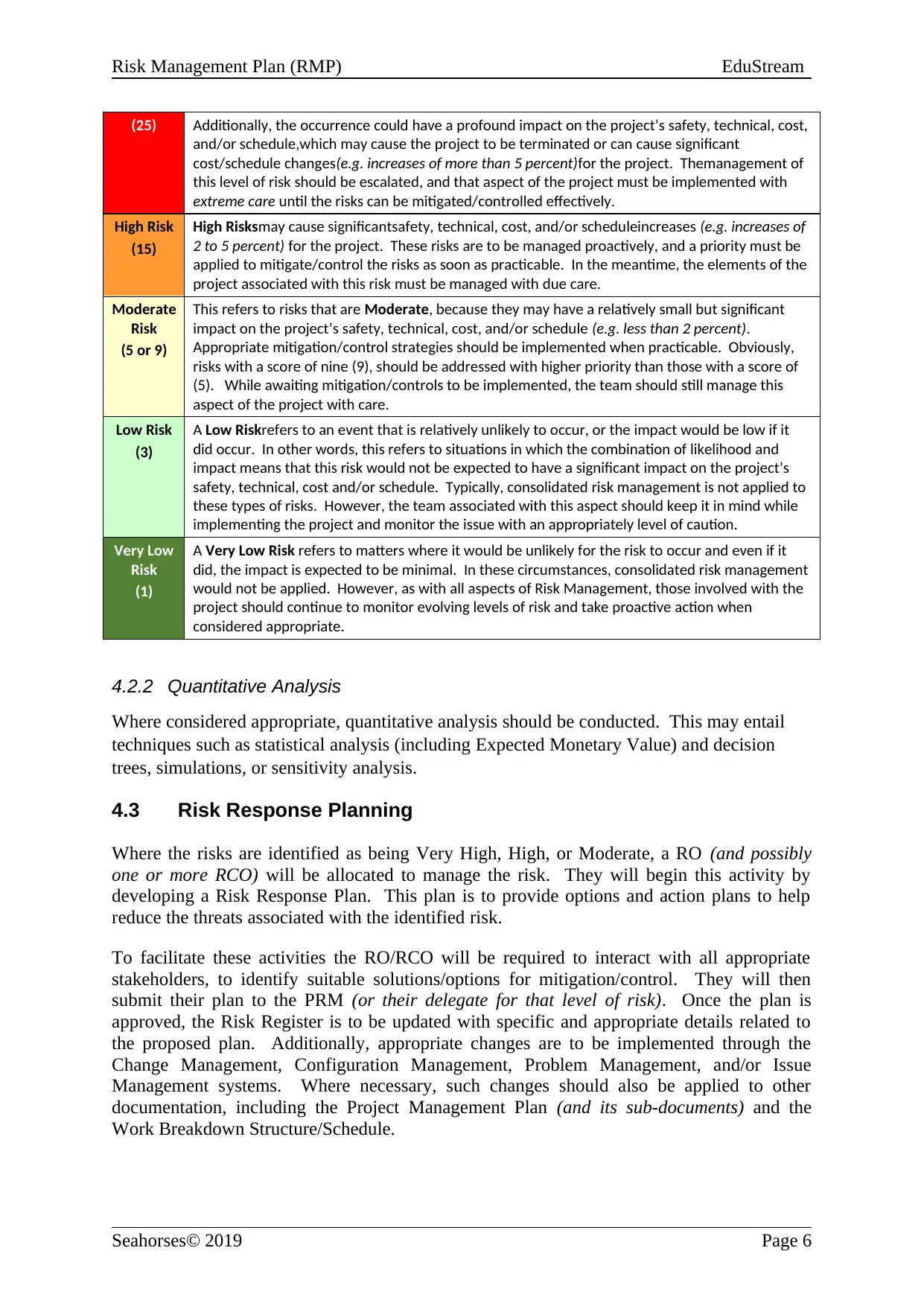
Risk Management Plan (RMP) EduStream
(25) Additionally, the occurrence could have a profound impact on the project’s safety, technical, cost,
and/or schedule,which may cause the project to be terminated or can cause significant
cost/schedule changes(e.g. increases of more than 5 percent)for the project. Themanagement of
this level of risk should be escalated, and that aspect of the project must be implemented with
extreme care until the risks can be mitigated/controlled effectively.
High Risk
(15)
High Risksmay cause significantsafety, technical, cost, and/or scheduleincreases (e.g. increases of
2 to 5 percent) for the project. These risks are to be managed proactively, and a priority must be
applied to mitigate/control the risks as soon as practicable. In the meantime, the elements of the
project associated with this risk must be managed with due care.
Moderate
Risk
(5 or 9)
This refers to risks that are Moderate, because they may have a relatively small but significant
impact on the project’s safety, technical, cost, and/or schedule (e.g. less than 2 percent).
Appropriate mitigation/control strategies should be implemented when practicable. Obviously,
risks with a score of nine (9), should be addressed with higher priority than those with a score of
(5). While awaiting mitigation/controls to be implemented, the team should still manage this
aspect of the project with care.
Low Risk
(3)
A Low Riskrefers to an event that is relatively unlikely to occur, or the impact would be low if it
did occur. In other words, this refers to situations in which the combination of likelihood and
impact means that this risk would not be expected to have a significant impact on the project’s
safety, technical, cost and/or schedule. Typically, consolidated risk management is not applied to
these types of risks. However, the team associated with this aspect should keep it in mind while
implementing the project and monitor the issue with an appropriately level of caution.
Very Low
Risk
(1)
A Very Low Risk refers to matters where it would be unlikely for the risk to occur and even if it
did, the impact is expected to be minimal. In these circumstances, consolidated risk management
would not be applied. However, as with all aspects of Risk Management, those involved with the
project should continue to monitor evolving levels of risk and take proactive action when
considered appropriate.
4.2.2 Quantitative Analysis
Where considered appropriate, quantitative analysis should be conducted. This may entail
techniques such as statistical analysis (including Expected Monetary Value) and decision
trees, simulations, or sensitivity analysis.
4.3 Risk Response Planning
Where the risks are identified as being Very High, High, or Moderate, a RO (and possibly
one or more RCO) will be allocated to manage the risk. They will begin this activity by
developing a Risk Response Plan. This plan is to provide options and action plans to help
reduce the threats associated with the identified risk.
To facilitate these activities the RO/RCO will be required to interact with all appropriate
stakeholders, to identify suitable solutions/options for mitigation/control. They will then
submit their plan to the PRM (or their delegate for that level of risk). Once the plan is
approved, the Risk Register is to be updated with specific and appropriate details related to
the proposed plan. Additionally, appropriate changes are to be implemented through the
Change Management, Configuration Management, Problem Management, and/or Issue
Management systems. Where necessary, such changes should also be applied to other
documentation, including the Project Management Plan (and its sub-documents) and the
Work Breakdown Structure/Schedule.
Seahorses© 2019 Page 6
(25) Additionally, the occurrence could have a profound impact on the project’s safety, technical, cost,
and/or schedule,which may cause the project to be terminated or can cause significant
cost/schedule changes(e.g. increases of more than 5 percent)for the project. Themanagement of
this level of risk should be escalated, and that aspect of the project must be implemented with
extreme care until the risks can be mitigated/controlled effectively.
High Risk
(15)
High Risksmay cause significantsafety, technical, cost, and/or scheduleincreases (e.g. increases of
2 to 5 percent) for the project. These risks are to be managed proactively, and a priority must be
applied to mitigate/control the risks as soon as practicable. In the meantime, the elements of the
project associated with this risk must be managed with due care.
Moderate
Risk
(5 or 9)
This refers to risks that are Moderate, because they may have a relatively small but significant
impact on the project’s safety, technical, cost, and/or schedule (e.g. less than 2 percent).
Appropriate mitigation/control strategies should be implemented when practicable. Obviously,
risks with a score of nine (9), should be addressed with higher priority than those with a score of
(5). While awaiting mitigation/controls to be implemented, the team should still manage this
aspect of the project with care.
Low Risk
(3)
A Low Riskrefers to an event that is relatively unlikely to occur, or the impact would be low if it
did occur. In other words, this refers to situations in which the combination of likelihood and
impact means that this risk would not be expected to have a significant impact on the project’s
safety, technical, cost and/or schedule. Typically, consolidated risk management is not applied to
these types of risks. However, the team associated with this aspect should keep it in mind while
implementing the project and monitor the issue with an appropriately level of caution.
Very Low
Risk
(1)
A Very Low Risk refers to matters where it would be unlikely for the risk to occur and even if it
did, the impact is expected to be minimal. In these circumstances, consolidated risk management
would not be applied. However, as with all aspects of Risk Management, those involved with the
project should continue to monitor evolving levels of risk and take proactive action when
considered appropriate.
4.2.2 Quantitative Analysis
Where considered appropriate, quantitative analysis should be conducted. This may entail
techniques such as statistical analysis (including Expected Monetary Value) and decision
trees, simulations, or sensitivity analysis.
4.3 Risk Response Planning
Where the risks are identified as being Very High, High, or Moderate, a RO (and possibly
one or more RCO) will be allocated to manage the risk. They will begin this activity by
developing a Risk Response Plan. This plan is to provide options and action plans to help
reduce the threats associated with the identified risk.
To facilitate these activities the RO/RCO will be required to interact with all appropriate
stakeholders, to identify suitable solutions/options for mitigation/control. They will then
submit their plan to the PRM (or their delegate for that level of risk). Once the plan is
approved, the Risk Register is to be updated with specific and appropriate details related to
the proposed plan. Additionally, appropriate changes are to be implemented through the
Change Management, Configuration Management, Problem Management, and/or Issue
Management systems. Where necessary, such changes should also be applied to other
documentation, including the Project Management Plan (and its sub-documents) and the
Work Breakdown Structure/Schedule.
Seahorses© 2019 Page 6
⊘ This is a preview!⊘
Do you want full access?
Subscribe today to unlock all pages.

Trusted by 1+ million students worldwide
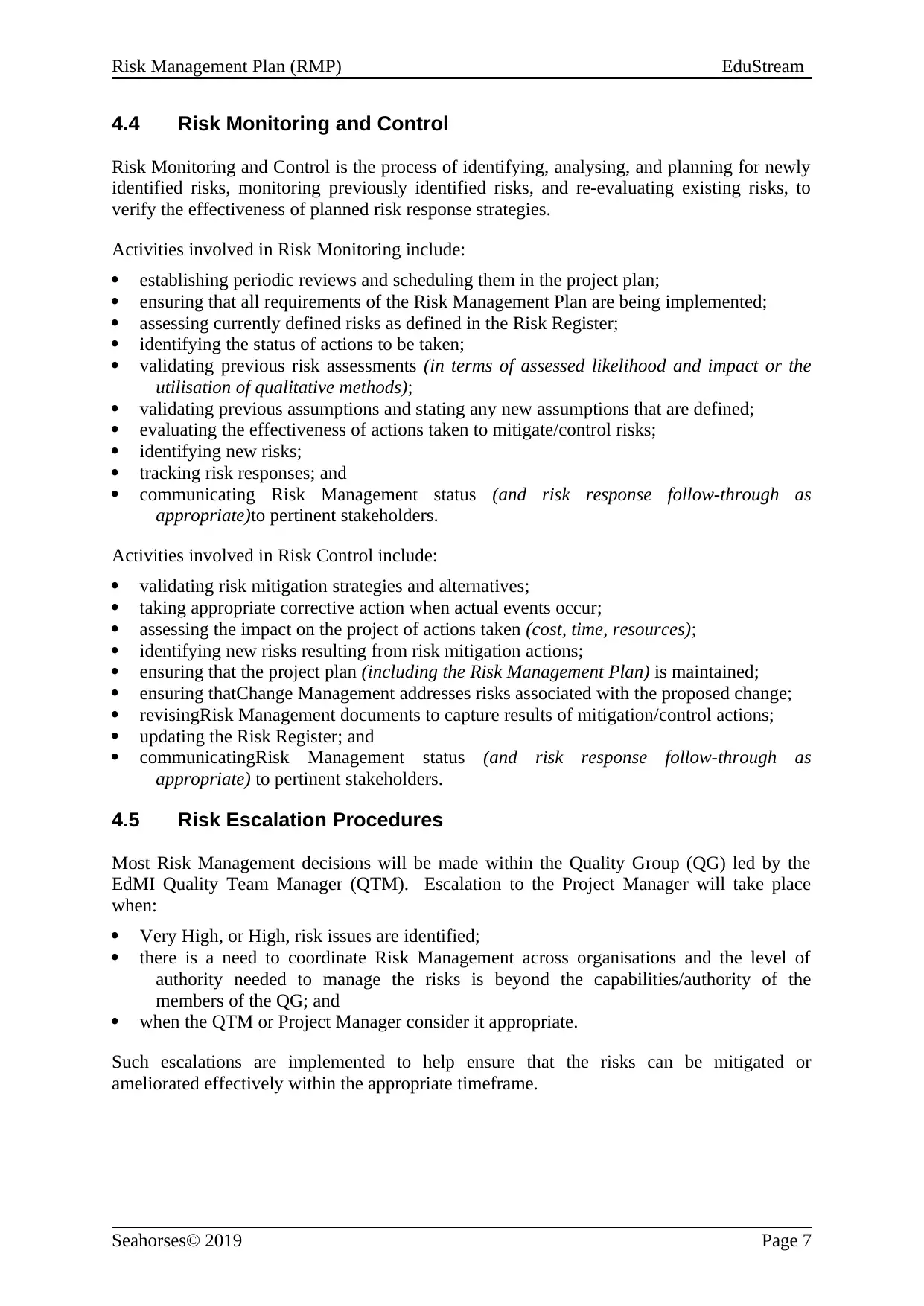
Risk Management Plan (RMP) EduStream
4.4 Risk Monitoring and Control
Risk Monitoring and Control is the process of identifying, analysing, and planning for newly
identified risks, monitoring previously identified risks, and re-evaluating existing risks, to
verify the effectiveness of planned risk response strategies.
Activities involved in Risk Monitoring include:
establishing periodic reviews and scheduling them in the project plan;
ensuring that all requirements of the Risk Management Plan are being implemented;
assessing currently defined risks as defined in the Risk Register;
identifying the status of actions to be taken;
validating previous risk assessments (in terms of assessed likelihood and impact or the
utilisation of qualitative methods);
validating previous assumptions and stating any new assumptions that are defined;
evaluating the effectiveness of actions taken to mitigate/control risks;
identifying new risks;
tracking risk responses; and
communicating Risk Management status (and risk response follow-through as
appropriate)to pertinent stakeholders.
Activities involved in Risk Control include:
validating risk mitigation strategies and alternatives;
taking appropriate corrective action when actual events occur;
assessing the impact on the project of actions taken (cost, time, resources);
identifying new risks resulting from risk mitigation actions;
ensuring that the project plan (including the Risk Management Plan) is maintained;
ensuring thatChange Management addresses risks associated with the proposed change;
revisingRisk Management documents to capture results of mitigation/control actions;
updating the Risk Register; and
communicatingRisk Management status (and risk response follow-through as
appropriate) to pertinent stakeholders.
4.5 Risk Escalation Procedures
Most Risk Management decisions will be made within the Quality Group (QG) led by the
EdMI Quality Team Manager (QTM). Escalation to the Project Manager will take place
when:
Very High, or High, risk issues are identified;
there is a need to coordinate Risk Management across organisations and the level of
authority needed to manage the risks is beyond the capabilities/authority of the
members of the QG; and
when the QTM or Project Manager consider it appropriate.
Such escalations are implemented to help ensure that the risks can be mitigated or
ameliorated effectively within the appropriate timeframe.
Seahorses© 2019 Page 7
4.4 Risk Monitoring and Control
Risk Monitoring and Control is the process of identifying, analysing, and planning for newly
identified risks, monitoring previously identified risks, and re-evaluating existing risks, to
verify the effectiveness of planned risk response strategies.
Activities involved in Risk Monitoring include:
establishing periodic reviews and scheduling them in the project plan;
ensuring that all requirements of the Risk Management Plan are being implemented;
assessing currently defined risks as defined in the Risk Register;
identifying the status of actions to be taken;
validating previous risk assessments (in terms of assessed likelihood and impact or the
utilisation of qualitative methods);
validating previous assumptions and stating any new assumptions that are defined;
evaluating the effectiveness of actions taken to mitigate/control risks;
identifying new risks;
tracking risk responses; and
communicating Risk Management status (and risk response follow-through as
appropriate)to pertinent stakeholders.
Activities involved in Risk Control include:
validating risk mitigation strategies and alternatives;
taking appropriate corrective action when actual events occur;
assessing the impact on the project of actions taken (cost, time, resources);
identifying new risks resulting from risk mitigation actions;
ensuring that the project plan (including the Risk Management Plan) is maintained;
ensuring thatChange Management addresses risks associated with the proposed change;
revisingRisk Management documents to capture results of mitigation/control actions;
updating the Risk Register; and
communicatingRisk Management status (and risk response follow-through as
appropriate) to pertinent stakeholders.
4.5 Risk Escalation Procedures
Most Risk Management decisions will be made within the Quality Group (QG) led by the
EdMI Quality Team Manager (QTM). Escalation to the Project Manager will take place
when:
Very High, or High, risk issues are identified;
there is a need to coordinate Risk Management across organisations and the level of
authority needed to manage the risks is beyond the capabilities/authority of the
members of the QG; and
when the QTM or Project Manager consider it appropriate.
Such escalations are implemented to help ensure that the risks can be mitigated or
ameliorated effectively within the appropriate timeframe.
Seahorses© 2019 Page 7
Paraphrase This Document
Need a fresh take? Get an instant paraphrase of this document with our AI Paraphraser
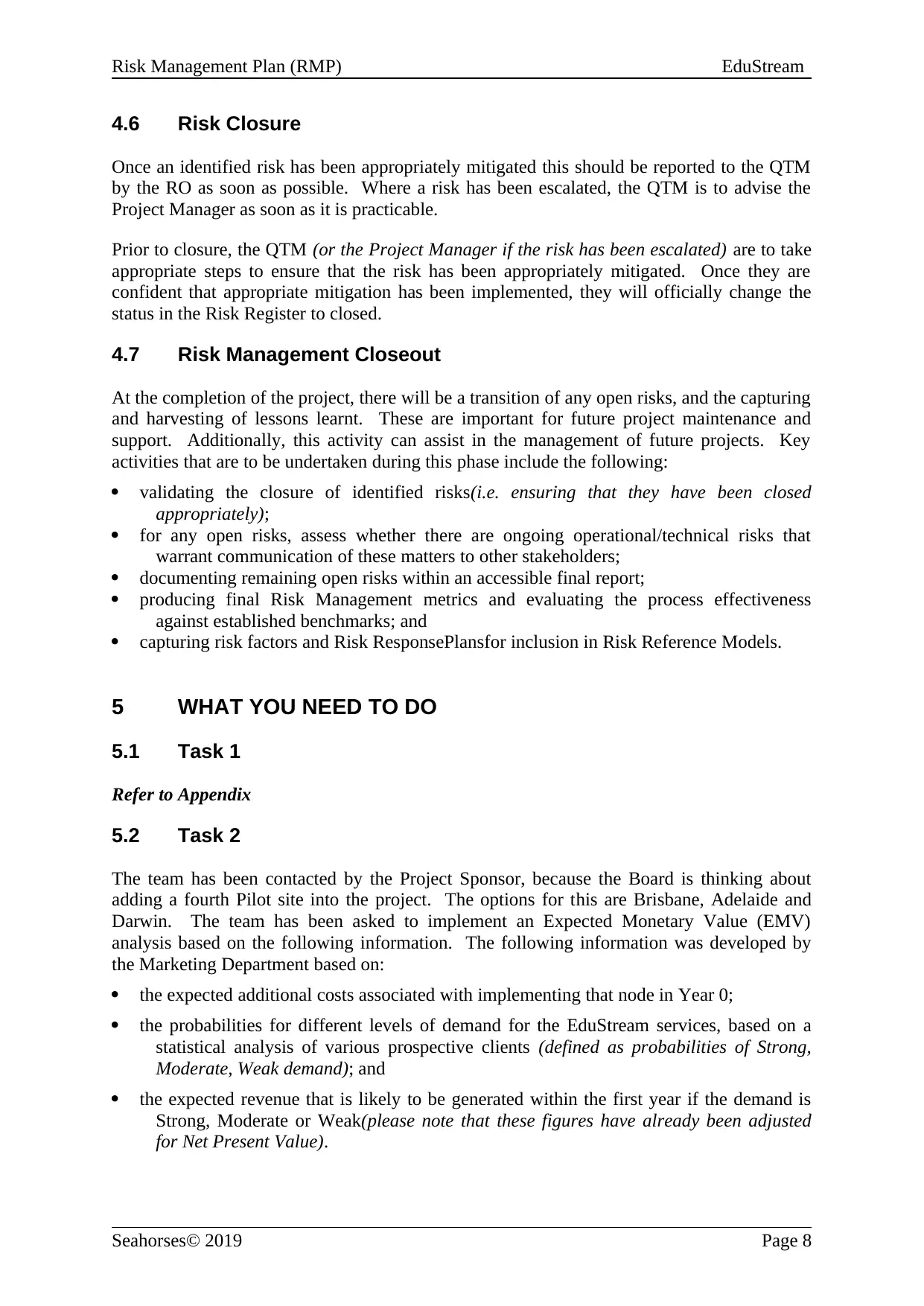
Risk Management Plan (RMP) EduStream
4.6 Risk Closure
Once an identified risk has been appropriately mitigated this should be reported to the QTM
by the RO as soon as possible. Where a risk has been escalated, the QTM is to advise the
Project Manager as soon as it is practicable.
Prior to closure, the QTM (or the Project Manager if the risk has been escalated) are to take
appropriate steps to ensure that the risk has been appropriately mitigated. Once they are
confident that appropriate mitigation has been implemented, they will officially change the
status in the Risk Register to closed.
4.7 Risk Management Closeout
At the completion of the project, there will be a transition of any open risks, and the capturing
and harvesting of lessons learnt. These are important for future project maintenance and
support. Additionally, this activity can assist in the management of future projects. Key
activities that are to be undertaken during this phase include the following:
validating the closure of identified risks(i.e. ensuring that they have been closed
appropriately);
for any open risks, assess whether there are ongoing operational/technical risks that
warrant communication of these matters to other stakeholders;
documenting remaining open risks within an accessible final report;
producing final Risk Management metrics and evaluating the process effectiveness
against established benchmarks; and
capturing risk factors and Risk ResponsePlansfor inclusion in Risk Reference Models.
5 WHAT YOU NEED TO DO
5.1 Task 1
Refer to Appendix
5.2 Task 2
The team has been contacted by the Project Sponsor, because the Board is thinking about
adding a fourth Pilot site into the project. The options for this are Brisbane, Adelaide and
Darwin. The team has been asked to implement an Expected Monetary Value (EMV)
analysis based on the following information. The following information was developed by
the Marketing Department based on:
the expected additional costs associated with implementing that node in Year 0;
the probabilities for different levels of demand for the EduStream services, based on a
statistical analysis of various prospective clients (defined as probabilities of Strong,
Moderate, Weak demand); and
the expected revenue that is likely to be generated within the first year if the demand is
Strong, Moderate or Weak(please note that these figures have already been adjusted
for Net Present Value).
Seahorses© 2019 Page 8
4.6 Risk Closure
Once an identified risk has been appropriately mitigated this should be reported to the QTM
by the RO as soon as possible. Where a risk has been escalated, the QTM is to advise the
Project Manager as soon as it is practicable.
Prior to closure, the QTM (or the Project Manager if the risk has been escalated) are to take
appropriate steps to ensure that the risk has been appropriately mitigated. Once they are
confident that appropriate mitigation has been implemented, they will officially change the
status in the Risk Register to closed.
4.7 Risk Management Closeout
At the completion of the project, there will be a transition of any open risks, and the capturing
and harvesting of lessons learnt. These are important for future project maintenance and
support. Additionally, this activity can assist in the management of future projects. Key
activities that are to be undertaken during this phase include the following:
validating the closure of identified risks(i.e. ensuring that they have been closed
appropriately);
for any open risks, assess whether there are ongoing operational/technical risks that
warrant communication of these matters to other stakeholders;
documenting remaining open risks within an accessible final report;
producing final Risk Management metrics and evaluating the process effectiveness
against established benchmarks; and
capturing risk factors and Risk ResponsePlansfor inclusion in Risk Reference Models.
5 WHAT YOU NEED TO DO
5.1 Task 1
Refer to Appendix
5.2 Task 2
The team has been contacted by the Project Sponsor, because the Board is thinking about
adding a fourth Pilot site into the project. The options for this are Brisbane, Adelaide and
Darwin. The team has been asked to implement an Expected Monetary Value (EMV)
analysis based on the following information. The following information was developed by
the Marketing Department based on:
the expected additional costs associated with implementing that node in Year 0;
the probabilities for different levels of demand for the EduStream services, based on a
statistical analysis of various prospective clients (defined as probabilities of Strong,
Moderate, Weak demand); and
the expected revenue that is likely to be generated within the first year if the demand is
Strong, Moderate or Weak(please note that these figures have already been adjusted
for Net Present Value).
Seahorses© 2019 Page 8
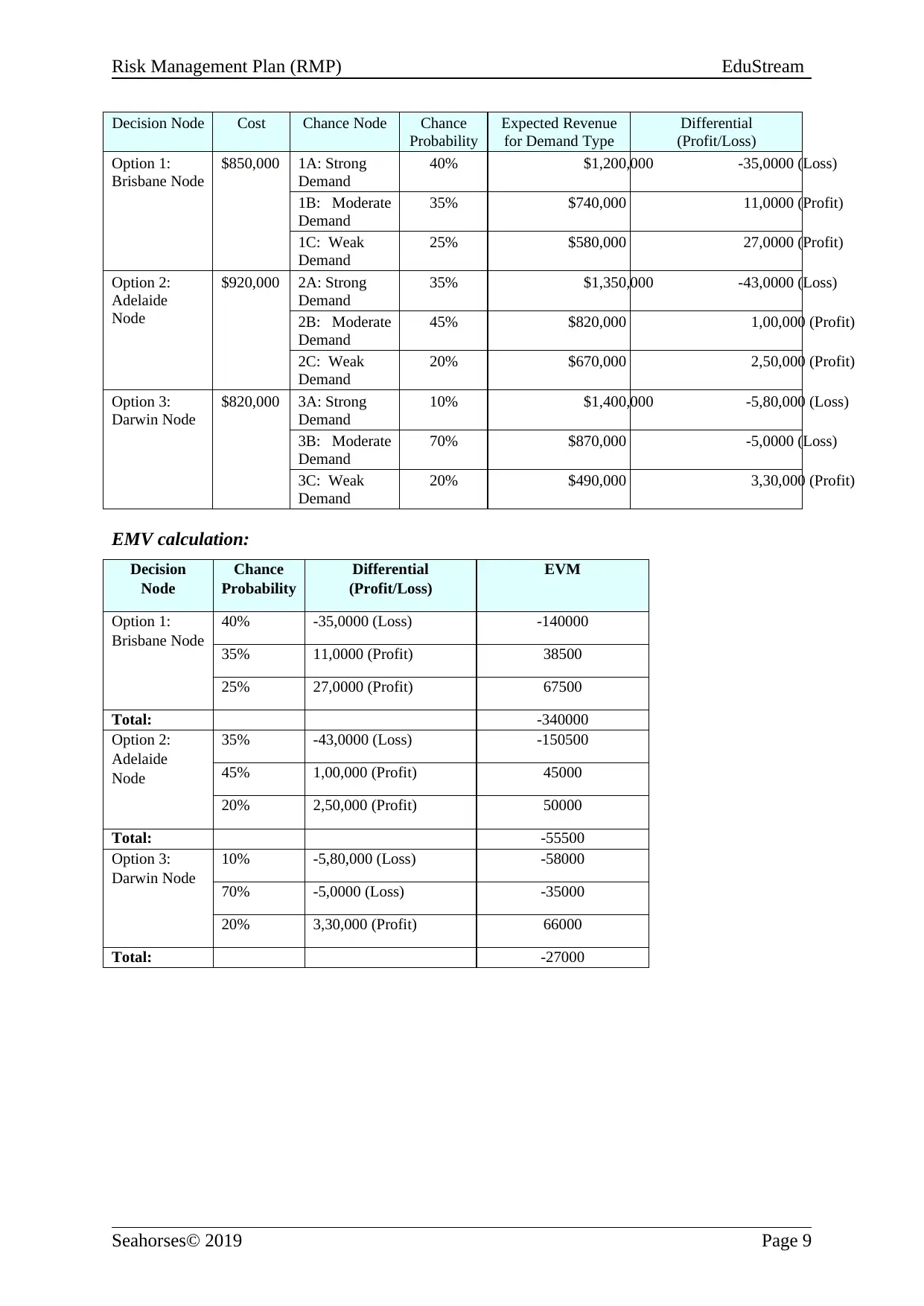
Risk Management Plan (RMP) EduStream
Decision Node Cost Chance Node Chance
Probability
Expected Revenue
for Demand Type
Differential
(Profit/Loss)
Option 1:
Brisbane Node
$850,000 1A: Strong
Demand
40% $1,200,000 -35,0000 (Loss)
1B: Moderate
Demand
35% $740,000 11,0000 (Profit)
1C: Weak
Demand
25% $580,000 27,0000 (Profit)
Option 2:
Adelaide
Node
$920,000 2A: Strong
Demand
35% $1,350,000 -43,0000 (Loss)
2B: Moderate
Demand
45% $820,000 1,00,000 (Profit)
2C: Weak
Demand
20% $670,000 2,50,000 (Profit)
Option 3:
Darwin Node
$820,000 3A: Strong
Demand
10% $1,400,000 -5,80,000 (Loss)
3B: Moderate
Demand
70% $870,000 -5,0000 (Loss)
3C: Weak
Demand
20% $490,000 3,30,000 (Profit)
EMV calculation:
Decision
Node
Chance
Probability
Differential
(Profit/Loss)
EVM
Option 1:
Brisbane Node
40% -35,0000 (Loss) -140000
35% 11,0000 (Profit) 38500
25% 27,0000 (Profit) 67500
Total: -340000
Option 2:
Adelaide
Node
35% -43,0000 (Loss) -150500
45% 1,00,000 (Profit) 45000
20% 2,50,000 (Profit) 50000
Total: -55500
Option 3:
Darwin Node
10% -5,80,000 (Loss) -58000
70% -5,0000 (Loss) -35000
20% 3,30,000 (Profit) 66000
Total: -27000
Seahorses© 2019 Page 9
Decision Node Cost Chance Node Chance
Probability
Expected Revenue
for Demand Type
Differential
(Profit/Loss)
Option 1:
Brisbane Node
$850,000 1A: Strong
Demand
40% $1,200,000 -35,0000 (Loss)
1B: Moderate
Demand
35% $740,000 11,0000 (Profit)
1C: Weak
Demand
25% $580,000 27,0000 (Profit)
Option 2:
Adelaide
Node
$920,000 2A: Strong
Demand
35% $1,350,000 -43,0000 (Loss)
2B: Moderate
Demand
45% $820,000 1,00,000 (Profit)
2C: Weak
Demand
20% $670,000 2,50,000 (Profit)
Option 3:
Darwin Node
$820,000 3A: Strong
Demand
10% $1,400,000 -5,80,000 (Loss)
3B: Moderate
Demand
70% $870,000 -5,0000 (Loss)
3C: Weak
Demand
20% $490,000 3,30,000 (Profit)
EMV calculation:
Decision
Node
Chance
Probability
Differential
(Profit/Loss)
EVM
Option 1:
Brisbane Node
40% -35,0000 (Loss) -140000
35% 11,0000 (Profit) 38500
25% 27,0000 (Profit) 67500
Total: -340000
Option 2:
Adelaide
Node
35% -43,0000 (Loss) -150500
45% 1,00,000 (Profit) 45000
20% 2,50,000 (Profit) 50000
Total: -55500
Option 3:
Darwin Node
10% -5,80,000 (Loss) -58000
70% -5,0000 (Loss) -35000
20% 3,30,000 (Profit) 66000
Total: -27000
Seahorses© 2019 Page 9
⊘ This is a preview!⊘
Do you want full access?
Subscribe today to unlock all pages.

Trusted by 1+ million students worldwide
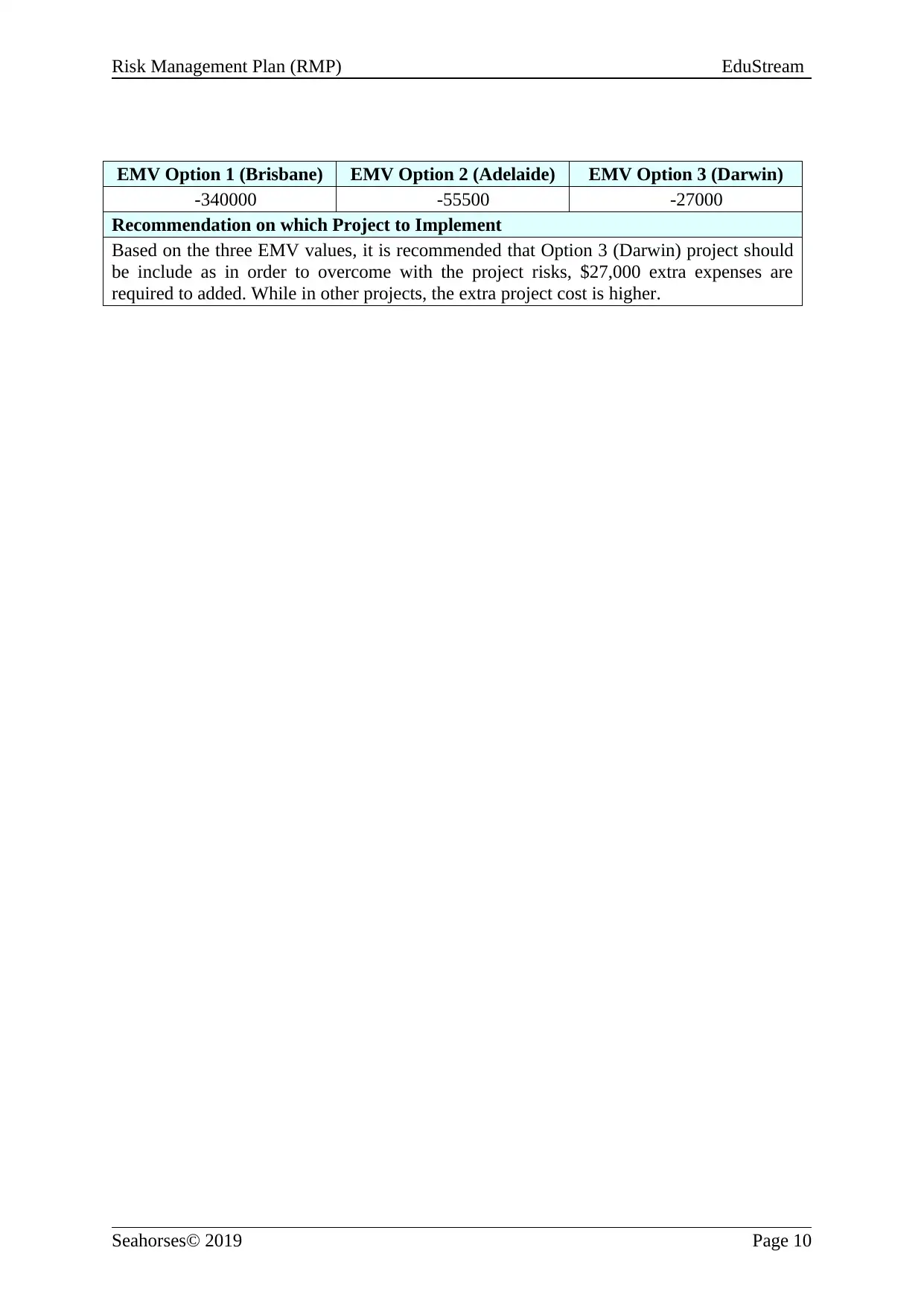
Risk Management Plan (RMP) EduStream
EMV Option 1 (Brisbane) EMV Option 2 (Adelaide) EMV Option 3 (Darwin)
-340000 -55500 -27000
Recommendation on which Project to Implement
Based on the three EMV values, it is recommended that Option 3 (Darwin) project should
be include as in order to overcome with the project risks, $27,000 extra expenses are
required to added. While in other projects, the extra project cost is higher.
Seahorses© 2019 Page 10
EMV Option 1 (Brisbane) EMV Option 2 (Adelaide) EMV Option 3 (Darwin)
-340000 -55500 -27000
Recommendation on which Project to Implement
Based on the three EMV values, it is recommended that Option 3 (Darwin) project should
be include as in order to overcome with the project risks, $27,000 extra expenses are
required to added. While in other projects, the extra project cost is higher.
Seahorses© 2019 Page 10
Paraphrase This Document
Need a fresh take? Get an instant paraphrase of this document with our AI Paraphraser
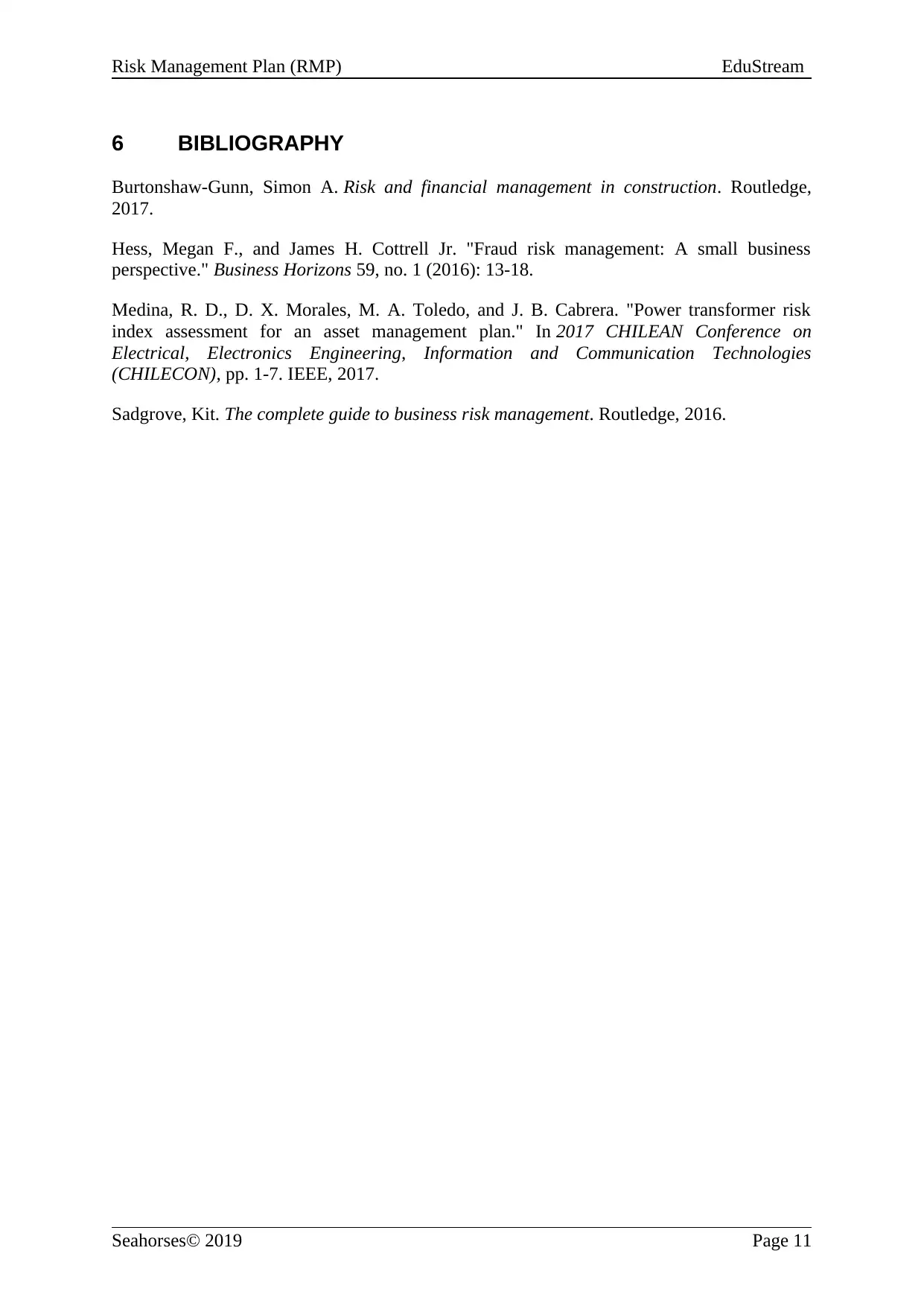
Risk Management Plan (RMP) EduStream
6 BIBLIOGRAPHY
Burtonshaw-Gunn, Simon A. Risk and financial management in construction. Routledge,
2017.
Hess, Megan F., and James H. Cottrell Jr. "Fraud risk management: A small business
perspective." Business Horizons 59, no. 1 (2016): 13-18.
Medina, R. D., D. X. Morales, M. A. Toledo, and J. B. Cabrera. "Power transformer risk
index assessment for an asset management plan." In 2017 CHILEAN Conference on
Electrical, Electronics Engineering, Information and Communication Technologies
(CHILECON), pp. 1-7. IEEE, 2017.
Sadgrove, Kit. The complete guide to business risk management. Routledge, 2016.
Seahorses© 2019 Page 11
6 BIBLIOGRAPHY
Burtonshaw-Gunn, Simon A. Risk and financial management in construction. Routledge,
2017.
Hess, Megan F., and James H. Cottrell Jr. "Fraud risk management: A small business
perspective." Business Horizons 59, no. 1 (2016): 13-18.
Medina, R. D., D. X. Morales, M. A. Toledo, and J. B. Cabrera. "Power transformer risk
index assessment for an asset management plan." In 2017 CHILEAN Conference on
Electrical, Electronics Engineering, Information and Communication Technologies
(CHILECON), pp. 1-7. IEEE, 2017.
Sadgrove, Kit. The complete guide to business risk management. Routledge, 2016.
Seahorses© 2019 Page 11
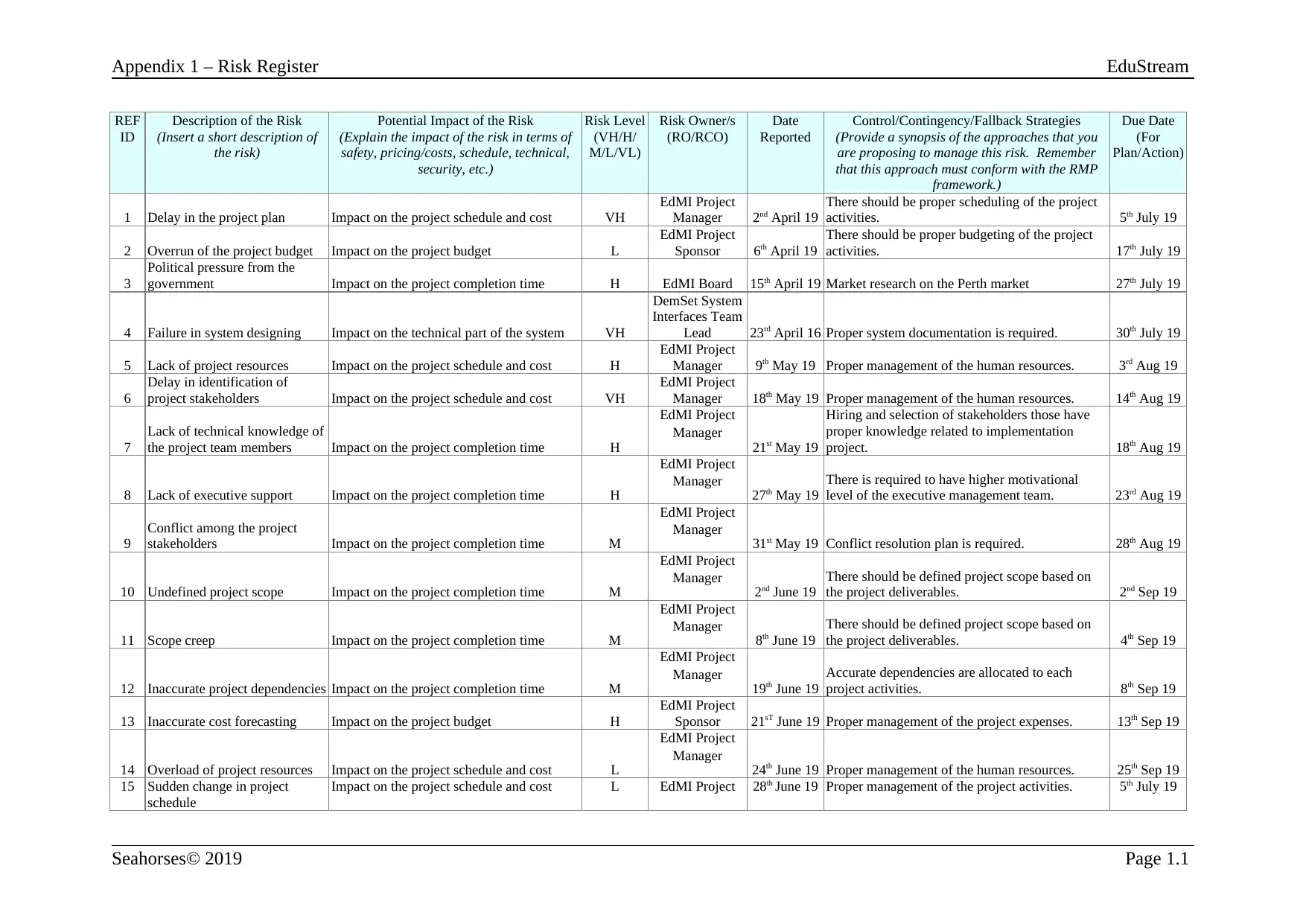
Appendix 1 – Risk Register EduStream
REF
ID
Description of the Risk
(Insert a short description of
the risk)
Potential Impact of the Risk
(Explain the impact of the risk in terms of
safety, pricing/costs, schedule, technical,
security, etc.)
Risk Level
(VH/H/
M/L/VL)
Risk Owner/s
(RO/RCO)
Date
Reported
Control/Contingency/Fallback Strategies
(Provide a synopsis of the approaches that you
are proposing to manage this risk. Remember
that this approach must conform with the RMP
framework.)
Due Date
(For
Plan/Action)
1 Delay in the project plan Impact on the project schedule and cost VH
EdMI Project
Manager 2nd April 19
There should be proper scheduling of the project
activities. 5th July 19
2 Overrun of the project budget Impact on the project budget L
EdMI Project
Sponsor 6th April 19
There should be proper budgeting of the project
activities. 17th July 19
3
Political pressure from the
government Impact on the project completion time H EdMI Board 15th April 19 Market research on the Perth market 27th July 19
4 Failure in system designing Impact on the technical part of the system VH
DemSet System
Interfaces Team
Lead 23rd April 16 Proper system documentation is required. 30th July 19
5 Lack of project resources Impact on the project schedule and cost H
EdMI Project
Manager 9th May 19 Proper management of the human resources. 3rd Aug 19
6
Delay in identification of
project stakeholders Impact on the project schedule and cost VH
EdMI Project
Manager 18th May 19 Proper management of the human resources. 14th Aug 19
7
Lack of technical knowledge of
the project team members Impact on the project completion time H
EdMI Project
Manager
21st May 19
Hiring and selection of stakeholders those have
proper knowledge related to implementation
project. 18th Aug 19
8 Lack of executive support Impact on the project completion time H
EdMI Project
Manager
27th May 19
There is required to have higher motivational
level of the executive management team. 23rd Aug 19
9
Conflict among the project
stakeholders Impact on the project completion time M
EdMI Project
Manager
31st May 19 Conflict resolution plan is required. 28th Aug 19
10 Undefined project scope Impact on the project completion time M
EdMI Project
Manager
2nd June 19
There should be defined project scope based on
the project deliverables. 2nd Sep 19
11 Scope creep Impact on the project completion time M
EdMI Project
Manager
8th June 19
There should be defined project scope based on
the project deliverables. 4th Sep 19
12 Inaccurate project dependencies Impact on the project completion time M
EdMI Project
Manager
19th June 19
Accurate dependencies are allocated to each
project activities. 8th Sep 19
13 Inaccurate cost forecasting Impact on the project budget H
EdMI Project
Sponsor 21sT June 19 Proper management of the project expenses. 13th Sep 19
14 Overload of project resources Impact on the project schedule and cost L
EdMI Project
Manager
24th June 19 Proper management of the human resources. 25th Sep 19
15 Sudden change in project
schedule
Impact on the project schedule and cost L EdMI Project 28th June 19 Proper management of the project activities. 5th July 19
Seahorses© 2019 Page 1.1
REF
ID
Description of the Risk
(Insert a short description of
the risk)
Potential Impact of the Risk
(Explain the impact of the risk in terms of
safety, pricing/costs, schedule, technical,
security, etc.)
Risk Level
(VH/H/
M/L/VL)
Risk Owner/s
(RO/RCO)
Date
Reported
Control/Contingency/Fallback Strategies
(Provide a synopsis of the approaches that you
are proposing to manage this risk. Remember
that this approach must conform with the RMP
framework.)
Due Date
(For
Plan/Action)
1 Delay in the project plan Impact on the project schedule and cost VH
EdMI Project
Manager 2nd April 19
There should be proper scheduling of the project
activities. 5th July 19
2 Overrun of the project budget Impact on the project budget L
EdMI Project
Sponsor 6th April 19
There should be proper budgeting of the project
activities. 17th July 19
3
Political pressure from the
government Impact on the project completion time H EdMI Board 15th April 19 Market research on the Perth market 27th July 19
4 Failure in system designing Impact on the technical part of the system VH
DemSet System
Interfaces Team
Lead 23rd April 16 Proper system documentation is required. 30th July 19
5 Lack of project resources Impact on the project schedule and cost H
EdMI Project
Manager 9th May 19 Proper management of the human resources. 3rd Aug 19
6
Delay in identification of
project stakeholders Impact on the project schedule and cost VH
EdMI Project
Manager 18th May 19 Proper management of the human resources. 14th Aug 19
7
Lack of technical knowledge of
the project team members Impact on the project completion time H
EdMI Project
Manager
21st May 19
Hiring and selection of stakeholders those have
proper knowledge related to implementation
project. 18th Aug 19
8 Lack of executive support Impact on the project completion time H
EdMI Project
Manager
27th May 19
There is required to have higher motivational
level of the executive management team. 23rd Aug 19
9
Conflict among the project
stakeholders Impact on the project completion time M
EdMI Project
Manager
31st May 19 Conflict resolution plan is required. 28th Aug 19
10 Undefined project scope Impact on the project completion time M
EdMI Project
Manager
2nd June 19
There should be defined project scope based on
the project deliverables. 2nd Sep 19
11 Scope creep Impact on the project completion time M
EdMI Project
Manager
8th June 19
There should be defined project scope based on
the project deliverables. 4th Sep 19
12 Inaccurate project dependencies Impact on the project completion time M
EdMI Project
Manager
19th June 19
Accurate dependencies are allocated to each
project activities. 8th Sep 19
13 Inaccurate cost forecasting Impact on the project budget H
EdMI Project
Sponsor 21sT June 19 Proper management of the project expenses. 13th Sep 19
14 Overload of project resources Impact on the project schedule and cost L
EdMI Project
Manager
24th June 19 Proper management of the human resources. 25th Sep 19
15 Sudden change in project
schedule
Impact on the project schedule and cost L EdMI Project 28th June 19 Proper management of the project activities. 5th July 19
Seahorses© 2019 Page 1.1
⊘ This is a preview!⊘
Do you want full access?
Subscribe today to unlock all pages.

Trusted by 1+ million students worldwide
1 out of 14
Related Documents
Your All-in-One AI-Powered Toolkit for Academic Success.
+13062052269
info@desklib.com
Available 24*7 on WhatsApp / Email
![[object Object]](/_next/static/media/star-bottom.7253800d.svg)
Unlock your academic potential
Copyright © 2020–2025 A2Z Services. All Rights Reserved. Developed and managed by ZUCOL.



